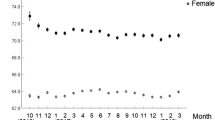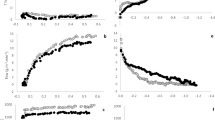Summary
Ten men, members of the International Biomedical Expedition to the Antarctic (IBEA), regularly recorded their thermal comfort, clothing, and activity for 60 days while travelling by motor toboggan and living in tents on the Antarctic plateau. Air temperature averaged −14‡ C (range +2‡ to −29‡ C) and wind speed 11 ms−1 (range 0 to 22 ms−1); on half the days there was wind-blown (“drift”) snow. Almost 2,000 sets of observations, evenly distributed throughout the 12 h sampling period 0700 h to 1900 h, were made. Daily (24 h) energy expenditure averaged 14.6 MJ on travelling days, 12.7 MJ on days when men worked in camp, and 13.3 MJ for the whole traverse. Men were outdoors for 7.6 h of the 12 h sampling period on travel days and for 3.6 h on camp days.
Bulky down-filled clothing, typical of that used by present-day polar expeditions, adequately protected the trunk from cold at the cost of overheating during exercise. Face, hands, and feet were less well protected, and they experienced cold-induced numbness and pain in 33%, 19%, and 12%, respectively, of the observations made in the coldest weather. Because men could not conveniently reduce clothing insulation to the extent required, sweating and discomfort from warmth increased with energy expenditure and were present in 60% of the observations made during heavy work. The results suggest that there is a need for improvements in clothing design which will permit a more complete adjustment to changes in activity.
The residual cold stress might possibly have been enough to induce cold acclimatization, although the accompanying heat stress was probably insufficient to induce acclimatization to heat.
Similar content being viewed by others
References
Bachelard C, Rivolier J (1984) Climate. International Biomedical Expedition to the Antarctic (IBEA), poster and abstract No. 14. Presented at the 6th Internat. Conf. Circumpolar Health, Anchorage, Alaska
Bedford T (1936) The warmth factor at work. Rep 76, Ind Hlth Res Bd, London
Belding HS, Russell HP, Darling RC, Folk GE (1947a) Thermal responses and efficiency of sweating when men are dressed in arctic clothing and exposed to extreme cold. Am J Physiol 149:204–222
Belding HS, Russell HP, Darling RC, Folk GE (1947b) Analysis of factors concerned in maintaining energy balance for dressed men in extreme cold; effects of activity on the protective value and comfort of an Arctic uniform. Am J Physiol 149:223–239
Boutelier C, Carette G, Loncle M, Regnard J (1984) Acclimation by cold baths. International Biomedical Expedition to the Antarctic (IBEA), poster and abstract No. 8. Presented at the 6th Internat. Conf. Circumpolar Health, Anchorage, Alaska
Boyd JJ (1975) The role of energy and fluid imbalance in weight changes found during field work in Antarctica. Br J Nutr 34:191–200
Brotherhood JR, Budd GM, Regnard J, Hendrie AL, Jeffery SE, Lincoln GJ (1986) The physical characteristics of the members during the International Biomedical Expedition to the Antarctic. Eur J Appl Physiol 55:517–523
Budd GM (1964) General acclimatization to cold in men studied before, during, and after a year in Antarctica. ANARE Report No 70. Antarctic Division, Department of External Affairs, Melbourne
Budd GM (1966) Skin temperature, thermal comfort, sweating, clothing and activity of men sledging in Antarctica. J Physiol 186:201–215
Budd GM (1973) Australian physiological research in the Antarctic and Subantarctic, with special reference to thermal stress and acclimatization. In: Edholm OG, Gunderson EKE (eds) Polar human biology. Heinemann Medical Books, London, pp 15–40
Budd GM (1974) Physiological research at Australian stations in the Antarctic and Subantarctic. In: Gunderson EKE (ed) Human adaptability to Antarctic conditions. Antarctic Research Series, vol 22. American Geophysical Union, Washington DC, pp 27–54
Budd GM, Hicks KE, Lugg DJ, Murray LG, Wigg DR (1969) Thermal discomfort in the Antarctic and Subantarctic. Med J Aust 2:1285–1288
Campbell IT (1982) Nutrition in adverse environments, 2: energy balance under polar conditions. Human Nutr: Appl Nutrit 36A:165–178
Cherry-Garrard A (1922) The worst journey in the world; Antarctic, 1910–1913. Constable, London
Glickman N, Keeton RW, Mitchell HH, Fahnestock MA (1946) The tolerance of man to cold as affected by dietary modifications: high versus low intake of certain water-soluble vitamins. Am J Physiol 146:538–558
Goldsmith R (1960) Use of clothing records to demonstrate acclimatization to cold in man. J Appl Physiol 15:776–780
Goldsmith R, Hampton IFG, Layman DB, Light I (1984a) Maximum oxygen consumption. International Biomedical Expedition to the Antarctic (IBEA), poster and abstract No. 13. Presented at the 6th Internat. Conf. Circumpolar Health, Anchorage, Alaska
Goldsmith R, Hampton IFG, Layman DB, Rantell JV (1984b) Microclimate. International Biomedical Expedition to the Antarctic (IBEA), poster and abstract No. 15. Presented at the 6th Internat. Conf. Circumpolar Health, Anchorage, Alaska
Goldsmith R, Hampton IFG, Layman DB, Rantell JV (1984c) Activity — heart rates. International Biomedical Expedition to the Antarctic (IBEA), poster and abstract No. 18. Presented at the 6th Internat. Conf. Circumpolar Health, Anchorage Alaska
Lugg DJ (1983) Nutrition — field phase. Unpublished report presented at IBEA workshop, Paris, January 1983
Lugg DJ (1984) Logistics. International Biomedical Expedition to the Antarctic (IBEA), poster and abstract No. 2. Presented at the 6th Internat. Conf. Circumpolar Health, Anchorage, Alaska
Masterton JP, Lewis HE, Widdowson EM (1957) Food intakes, energy expenditures and faecal excretions of men on a polar expedition. Br J Nutr 11:346–358
Nansen F (1985) The first crossing of Greenland (transl. Gepp HM). Longmans Green, New York
Nie NH, Hull CH, Jenkins JG, Steinbrenner K, Bent DH (1975) SPSS — Statistical package for the social sciences. McGraw Hill, New York
Oakley EHN (1984) The design and function of military footwear: a review following experiences in the South Atlantic. Ergonomics 27:631–637
Passmore R, Durnin JVGA (1955) Human energy expenditure. Physiol Rev 35:801–840
Regnard J, Goldsmith R, Fouillot JP (1984) A traverse day workload. International Biomedical Expedition to the Antarctic (IBEA), poster and abstract No. 17. Presented at the 6th Internat. Conf. Circumpolar Health, Anchorage, Alaska
Rivolier J (1984) Aims and programme. International Biomedical Expedition to the Antarctic (IBEA), poster and abstract No. 1. Presented at the 6th Internat. Conf. Circumpolar Health, Anchorage, Alaska
Rivolier J, Bachelard C, Regnard J (1984) Cooling power and heat exchange. International Biomedical Expedition to the Antarctic (IBEA), poster and abstract No. 23. Presented at the 6th Internat. Conf. Circumpolar Health, Anchorage, Alaska
Robertson JM, Reid DD (1952) Standards for basal metabolism of normal people in Britain. Lancet 1:940–943
Siple PA, Passel CF (1945) Measurements of dry atmospheric cooling in subfreezing temperatures. Proc Am Phil Soc 89:177–199
Skreslet S, Aarefjord F (1968) Acclimatization to cold in man induced by frequent scuba diving in cold water. J Appl Physiol 24:177–181
Wilkins DC (1973) Acclimation to heat in the Antarctic. In: Edholm OG, Gunderson EKE (eds) Polar human biology. Heinemann Medical Books, London, pp 171–181
Author information
Authors and Affiliations
Rights and permissions
About this article
Cite this article
Budd, G.M., Hendrie, A.L. & Jeffery, S.E. Behavioural temperature regulation during a motor-toboggan traverse in Antarctica. Europ. J. Appl. Physiol. 55, 507–516 (1986). https://doi.org/10.1007/BF00421646
Accepted:
Issue Date:
DOI: https://doi.org/10.1007/BF00421646




